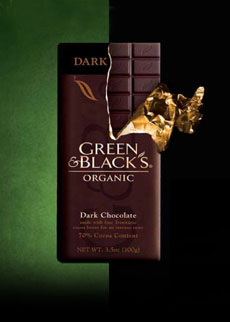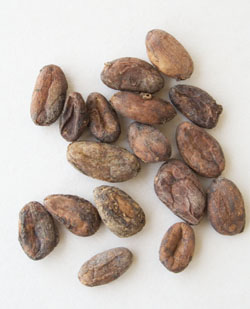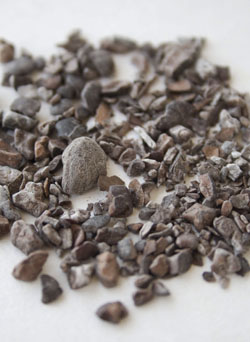

Green & Black’s 70% cacao chocolate bar is serious stuff: intense cacao flavor with a bitter profile. There’s plenty of sybaritic eating, though, in this extensive line. Photography courtesy of Green & Black’s.
|
PETER ROT is THE NIBBLE’s chocolate specialist.
|
July 2009
|
 |
Green & Black’s Organic Chocolate Bars
A Pioneer In Organic Dark Chocolate
Page 1: Overview Of Organic Chocolate
CAPSULE REPORT: If you regularly buy organic chocolate, you’ve probably tried Green & Black’s. If you’re not “experienced” with G&B’s, you’re in luck: The line is widely available at retail as well as online. The U.K.-based company was a pioneer in the organic chocolate space, the world’s first organic, Fair Trade chocolate company. It has helped the cacao farmers of Belize stay on their farms and do what they love—grow cacao—instead of taking city jobs to support their families. Green & Black’s has proved that a company can be committed to environmental sustainability and Fair Trade prices, and still make a tidy profit. In fact, Green & Black’s organic chocolate is the U.K.’s fastest-growing confectionary brand, which prompted corporate giant Cadbury Schweppes to purchase Green & Black’s, in which it had a small stake, in May 2005. This is Page 1 of a four-page article. Click on the black links below to visit other pages.
Overview Of Organic Chocolate
Organic chocolate has come a long way since the early 1990s, when the first bars were commercially available to the public. At that time, organic foods were virtually unheard of outside of farmers markets and health food or “natural food” stores. As strange as it may seem, given today’s focus on organics, there was very little interest in organic food, and almost no organic chocolate to speak of.
Adding insult to injury was the lack of quality among the organic chocolate that could  be found. With over-roasted and musty flavors, and textures that melted with considerable grain and grit, consumers were more than unimpressed. Early organic chocolate, on average, contained more bitterness and tannins—traits that have never been in fashion regardless of what label the chocolate is wearing. be found. With over-roasted and musty flavors, and textures that melted with considerable grain and grit, consumers were more than unimpressed. Early organic chocolate, on average, contained more bitterness and tannins—traits that have never been in fashion regardless of what label the chocolate is wearing.
Photo of Green & Black’s cacao beans by
Claire Freierman | THE NIBBLE. The beans are
found inside the pod, or cabosse (see photo), that
grows on the cacao tree.
In the “conventional” luxury chocolate market at the time, only a handful of companies such as Valrhona and Michel Cluizel were offering knowledgeable chocolate consumers chocolates at the pinnacle of quality; larger manufacturers, such as Callebaut and Belcolade, provided premium chocolate at the wholesale level. These chocolates were, as a whole, uniform in quality and fine in flavor and texture. They delivered every trait that a luxury food was supposed to, whereas organic chocolate did not.
The Evolution Of Organic Chocolate
Only within the past 10 years or so has organic chocolate been able to gain a firm footing in the consciousness of chocolate connoisseurs. The reasons why it took so long are varied.
- Some companies adhered to a style that harkened to the chocolate’s grassroots appeal, reflecting on flavor and texture in ways that were not appealing to conventional chocolate consumers. Dry, astringent and earthy are words that could sum up early organic chocolate.
- Another reason may have been that processing standards and growing practices for organic cacao were not as refined and tightly controlled as they are today.
- Public interest in non-organic fine chocolate was still in its infancy, so people did not seek out organic alternatives; they were still adjusting to the complexities and intricacies of regular “gourmet” chocolate.
There was a chicken-and-egg scenario: Fine chocolate in general would need to be  accepted by the public as a highly desirable food they would pay premium prices for, like good wine, before organic chocolate could thrive as well. Yet, at the same time, in order to be seen as desirable, organic chocolate producers would need to produce bars at a level of fine non-organic chocolate. This was a daunting feat considering that so many odds were stacked against organic chocolate at the time. accepted by the public as a highly desirable food they would pay premium prices for, like good wine, before organic chocolate could thrive as well. Yet, at the same time, in order to be seen as desirable, organic chocolate producers would need to produce bars at a level of fine non-organic chocolate. This was a daunting feat considering that so many odds were stacked against organic chocolate at the time.
Photo of Green & Black’s cacao nibs by
Claire Freierman | THE NIBBLE. The nibs are
inside the cacao beans (photo above).
Luckily, as interest (and hence demand) for chocolate grew, so did public awareness of the terrible working conditions on cacao plantations and the plight of small cacao farmers, the negative environmental impact of cacao farming, and the desire of Americans and others worldwide to feel closely connected to the source of our food. All of these factors helped to bolster the demand for organically grown cacao and, in turn, raise production standards (as well as the quality of life for cacao farmers and the adoption of more sustainable farming practices).
Organic Cacao Today
Thanks to the efforts of several key entrepreneurs, today organic chocolate is as well recognized as organic fruit and organic milk. Green & Black’s launched its first organic chocolate bar in the U.K. in 1991. Terra Nostra Organic was founded in Canada in 1998. Dagoba, founded in 2001, was the U.S. pioneer. Prior to then, production of organic chocolate by U.S. companies was conducted overseas; the finished chocolate was shipped to the U.S. Following the success of Dagoba, Green & Black’s was imported into the U.S. in 2003.
Each of these companies produced exclusively organic chocolate at a quality level comparable to prestigious non-organic brands. Another organic powerhouse, Theo, upped the ante in 2006 by becoming the first producer to manufacture organic, Fair Trade chocolate in the United States, at a level of the finest European chocolate producers.
Despite the long road to refinement that organic chocolate has taken, there are still  too many brands that reflect the organic movement’s earlier days—either as homage to its rustic roots, or because a company’s processes have not been completely ironed out. Many of these bars are produced from smaller companies that operate from the country where the beans were sourced (e.g. Kallari and Republica del Cacao), and others are even produced by larger, more globally successful brands such as the ones we like and have reviewed. Seen by non-organic chocolate eaters as flaws, a light grit to the texture can sometimes add a rustic appeal to the chocolate, and even hints of over-roasted beans may add a pleasant depth to the flavor—depending on one’s taste preferences. too many brands that reflect the organic movement’s earlier days—either as homage to its rustic roots, or because a company’s processes have not been completely ironed out. Many of these bars are produced from smaller companies that operate from the country where the beans were sourced (e.g. Kallari and Republica del Cacao), and others are even produced by larger, more globally successful brands such as the ones we like and have reviewed. Seen by non-organic chocolate eaters as flaws, a light grit to the texture can sometimes add a rustic appeal to the chocolate, and even hints of over-roasted beans may add a pleasant depth to the flavor—depending on one’s taste preferences.
But you can count on this: We’ve tasted them all, and we will tell you what we think!
Photo: Conched chocolate, ready to be tempered, then molded into bars. Review the chocolate-making process.
Continue To Page 2: History Of Green & Black's
Go To The Article Index Above
Lifestyle Direct, Inc. All rights reserved. Images are the copyright of their respective owners.

|





 be found. With over-roasted and musty flavors, and textures that melted with considerable grain and grit, consumers were more than unimpressed. Early organic chocolate, on average, contained more bitterness and tannins—traits that have never been in fashion regardless of what label the chocolate is wearing.
be found. With over-roasted and musty flavors, and textures that melted with considerable grain and grit, consumers were more than unimpressed. Early organic chocolate, on average, contained more bitterness and tannins—traits that have never been in fashion regardless of what label the chocolate is wearing.  accepted by the public as a highly desirable food they would pay premium prices for, like good wine, before organic chocolate could thrive as well. Yet, at the same time, in order to be seen as desirable, organic chocolate producers would need to produce bars at a level of fine non-organic chocolate. This was a daunting feat considering that so many odds were stacked against organic chocolate at the time.
accepted by the public as a highly desirable food they would pay premium prices for, like good wine, before organic chocolate could thrive as well. Yet, at the same time, in order to be seen as desirable, organic chocolate producers would need to produce bars at a level of fine non-organic chocolate. This was a daunting feat considering that so many odds were stacked against organic chocolate at the time. 